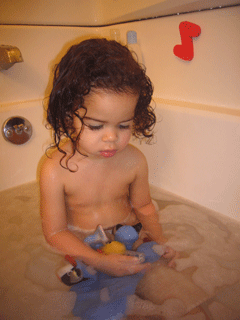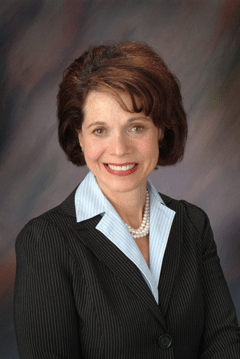Dioxane on the Defensive
Air Date: Week of September 7, 2007

Leila Love enjoys a nighttime bath. (Photo: Victoria Love)
A recent study finds levels of dioxane, a chemical that causes cancer in mice and rats, in several name brand soaps and shampoos for kids. Dioxane is banned from cosmetics in the European Union but the U.S. federal government has not set limits for dioxane in consumer products. Living on Earth’s Ashley Ahearn reports.
Transcript
CURWOOD: Bath time is one of the nicest rituals in caring for an infant. But it now turns out it could have a toxic dark side. A recent study has found that some of the most popular baby shampoos contain an industrial solvent that is suspected of causing cancer in humans, along with damaging the liver, kidneys, and nervous system. It’s called 1,4 Dioxane, and it is used to make shampoos and body washes, soft and bubbly. Now in the wake of the study some brands of shampoos containing the chemical are being pulled from the market. Living on Earth’s Ashley Ahearn has our report.
LOVE: Nice warm water wooooohh! There you go.
AHEARN: It’s bath time in the Love-Diggory household in Boston, MA and two-year-old Leila is getting her hair rinsed.
LOVE: Leila, can you put this over your eyes?
LEILA: No

Leila Love-Diggory enjoys a nighttime bath. (Photo: Victoria Love)
AHEARN: Victoria Love is trying to get Leila to put a washcloth over her big brown eyes to keep out the shampoo.
And while she can protect Leila’s eyes from the suds, she can’t protect her daughter from potentially dangerous substances that might be in her shampoo and other baby care products.
One substance in particular Love worries about is 1,4 Dioxane and with good reason. A recent study has found trace amounts of Dioxane in a number of widely-used baby care products, including Johnson and Johnson’s Kid Shampoo Watermelon Explosion, and Hello Kitty bubble bath.
DAVIS: I was frankly shocked to learn that widely used baby shampoos and soaps could contain a carcinogen.
AHEARN: That’s Dr. Devra Davis. She’s the head of the Environmental Oncology Center at the University of Pittsburgh and a professor of epidemiology at their Graduate School of Public Health.
Dioxane forms in these products as a result of a chemical reaction between other ingredients. One of them is Sodium Laurel Sulphate, an ingredient you’ve probably seen on the label of your shampoo or body wash.
It’s a normal detergent used in many soaps. Problem is, Dr. Davis says it’s a little harsh on tender skin.
She gives a little chemistry lesson:
DAVIS: What happens is that ethylene-oxide is added to the Sodium Laurel Sulphate to create Sodium Laureth Sulfate and in the process you get Di-Ethylene Oxide, which is another name for 1,4 Dioxane. It can be completely removed by what’s called vacuum stripping. This is something that is completely avoidable.
AHEARN: And Dr. Davis says elsewhere, it’s completely avoided.
DAVIS: 1,4 Dioxane, has been banned from cosmetics in Europe and the World Health Organization and the U.S. National Toxicology Program consider it to be a probable human carcinogen, because it causes cancer in male and female mice and rats.

Dr. Devra Davis (Courtesy of the University of Pittsburgh)
In order for the F.D.A. to ban Dioxane from cosmetics, there would have to be demonstrated human harm.
Manufacturers complete internal testing for safety before putting products on the market, but the F.D.A. doesn’t do pre-market testing.
The F.D.A. press office declined requests for an interview with Living on Earth.
However, an Industry spokesman said he believes there’s no cause for alarm.
Dr. John Bailey is the executive vice president of science at the Cosmetic, Toiletry and Fragrance Association.
BAILEY: Virtually everything we’re surrounded by carries a hazard of some sort. I think that at the end of the day the levels of Dioxane in these products do not present a risk by any scientific measure.
[SPLASHING]
LOVE: Time to get out!
AHEARN: But when it comes to bathtime, Victoria Love would like to judge the safety of the products herself. At the very least she says she’d like ingredients such as 1,4 Dioxane to be listed on the bottle.
LOVE: But I really can’t believe that as a parent I’m in a position to you know, suddenly become a chemist in my free time to investigate, you know, every little product and you know, how it might have some adverse health effect and I’m hoping that the more people understand and realize, you know, what they’re actually being sold, people will start demanding change.
AHEARN: Some change is already in the works. Hello Kitty Bubble Bath had the highest Dioxane levels of the children’s bath products the study tested. And when contacted for this report, the distributor said they would initiate a recall process.
For Living on Earth, I’m Ashley Ahearn.
Links
To find out what’s in the products you use every day go to
To view the lab results from the independent study on dioxane, click here
Living on Earth wants to hear from you!
Living on Earth
62 Calef Highway, Suite 212
Lee, NH 03861
Telephone: 617-287-4121
E-mail: comments@loe.org
Newsletter [Click here]
Donate to Living on Earth!
Living on Earth is an independent media program and relies entirely on contributions from listeners and institutions supporting public service. Please donate now to preserve an independent environmental voice.
NewsletterLiving on Earth offers a weekly delivery of the show's rundown to your mailbox. Sign up for our newsletter today!
 Sailors For The Sea: Be the change you want to sea.
Sailors For The Sea: Be the change you want to sea.
 The Grantham Foundation for the Protection of the Environment: Committed to protecting and improving the health of the global environment.
The Grantham Foundation for the Protection of the Environment: Committed to protecting and improving the health of the global environment.
 Contribute to Living on Earth and receive, as our gift to you, an archival print of one of Mark Seth Lender's extraordinary wildlife photographs. Follow the link to see Mark's current collection of photographs.
Contribute to Living on Earth and receive, as our gift to you, an archival print of one of Mark Seth Lender's extraordinary wildlife photographs. Follow the link to see Mark's current collection of photographs.
 Buy a signed copy of Mark Seth Lender's book Smeagull the Seagull & support Living on Earth
Buy a signed copy of Mark Seth Lender's book Smeagull the Seagull & support Living on Earth

